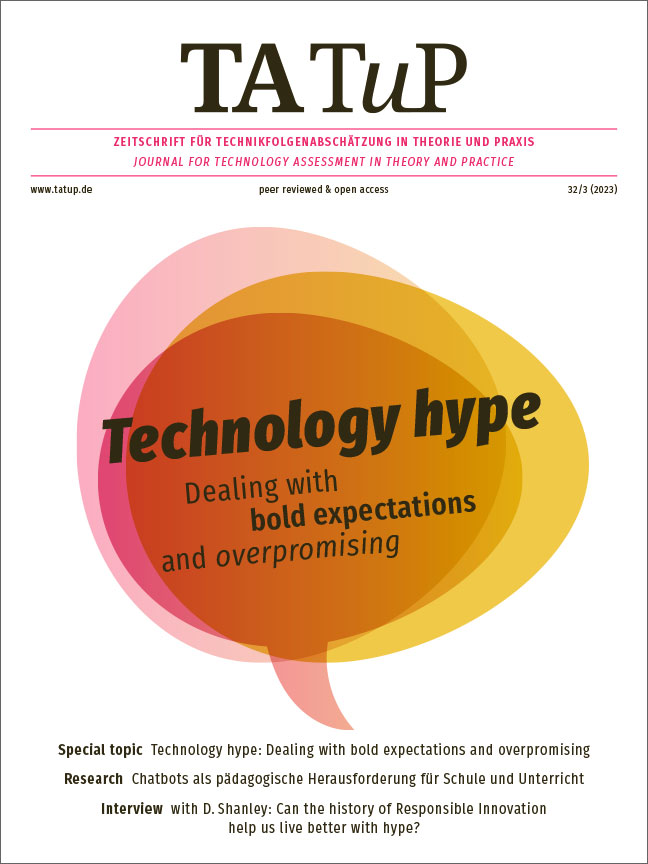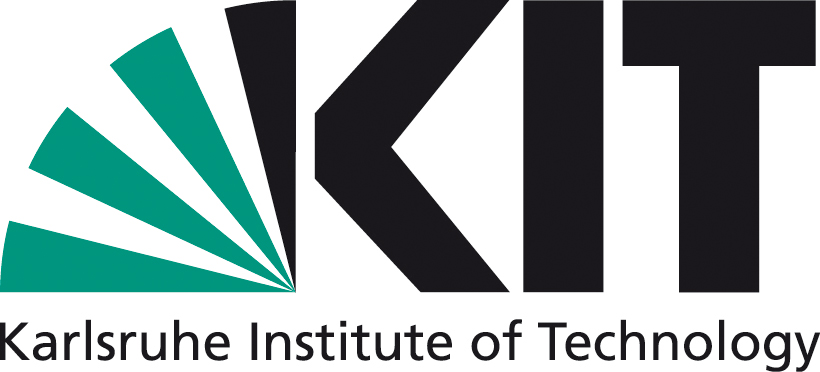Technology hypes: Practices, approaches and assessments
DOI:
https://doi.org/10.14512/tatup.32.3.11Keywords:
hype, overpromising, expectations, emerging technologyAbstract
To date, the study of hype has become a productive but also eclectic field of research. This introduction provides an overview of the core characteristics of technology hype and distinguishes it from other future-oriented concepts. Further, the authors present promising approaches from various disciplines for studying, critiquing, and dealing with hype. The special issue assembles case studies, methodological and theoretical contributions that analyze tech hypes’ temporality, agency, and institutional dynamics. It provides insights into how hypes are triggered and fostered, but also how they can be deconstructed and anticipated.
References
Auch, Adam (2013): Virtuous argumentation and the challenges of hype. In: Ontario Society for the Study of Argumentation 10: Virtues of Argumentation. Available online at https://core.ac.uk/download/pdf/72768221.pdf, last accessed on 07. 11. 2023.
Bareis, Jascha; Katzenbach, Christian (2022): Talking AI into being. The narratives and imaginaries of national AI strategies and their performative politics. In: Science, Technology, & Human Values 47 (5), pp. 855–881. https://doi.org/10.1177/01622439211030007 DOI: https://doi.org/10.1177/01622439211030007
Beckert, Jens (2016): Imagined futures. Fictional expectations and capitalist dynamics. Cambridge, MA: Harvard University Press. DOI: https://doi.org/10.4159/9780674545878
Bensaude Vincent, Bernadette (2014): The politics of buzzwords at the interface of technoscience, market and society. The case of ‘public engagement in science’. In: Public Understanding of Science 23 (3), pp. 238–253. https://doi.org/10.1177/0963662513515371 DOI: https://doi.org/10.1177/0963662513515371
Birch, Kean (2017): Rethinking value in the bio-economy. Finance, assetization, and the management of value. In: Science, Technology, & Human Values 42 (3), pp. 460–490. https://doi.org/10.1177/0162243916661633 DOI: https://doi.org/10.1177/0162243916661633
Bordignon, Frederique; Ermakova, Liana; Noel, Marianne (2021): Over-promotion and caution in abstracts of preprints during the COVID-19 crisis. In: Learned Publishing. Journal of the Association of Learned and Professional Society Publishers 34 (4), pp. 622–636. https://doi.org/10.1002/leap.1411 DOI: https://doi.org/10.1002/leap.1411
Chen, Chaomei (2006): CiteSpace II. Detecting and visualizing emerging trends and transient patterns in scientific literature. In: Journal of the American Society for Information Science and Technology 57 (3), pp. 359–377. https://doi.org/10.1002/asi.20317 DOI: https://doi.org/10.1002/asi.20317
Chen, Chaomei; Hu, Zhigang; Liu, Shengbo; Tseng, Hung (2012): Emerging trends in regenerative medicine. A scientometric analysis in CiteSpace. In: Expert Opinion on Biological Therapy 12 (5), pp. 593–608. https://doi.org/10.1517/14712598.2012.674507 DOI: https://doi.org/10.1517/14712598.2012.674507
Dedehayir, Ozgur; Steinert, Martin (2016): The hype cycle model. A review and future directions. In: Technological Forecasting and Social Change 108, pp. 28–41. https://doi.org/10.1016/j.techfore.2016.04.005 DOI: https://doi.org/10.1016/j.techfore.2016.04.005
Dierkes, Meinolf; Hoffmann, Ute; Marz, Lutz (1996): Visions of technology. Social and institutional factors shaping the development of new technologies. Frankfurt: Campus.
Gillespie, Tarleton (2018): Custodians of the internet. Platforms, content moderation, and the hidden decisions that shape social media. New Haven, CT: Yale University Press. https://doi.org/10.12987/9780300235029 DOI: https://doi.org/10.12987/9780300235029
Goffman, Erving (1990): The presentation of self in everyday life. London: Penguin.
Goldfarb, Brent; Kirsch, David (2019): Bubbles and crashes. The boom and bust of technological innovation. Stanford: Stanford University Press. https://doi.org/10.1515/9781503607934 DOI: https://doi.org/10.1515/9781503607934
Gorwa, Robert; Binns, Reuben; Katzenbach, Christian (2020): Algorithmic content moderation. Technical and political challenges in the automation of platform governance. In: Big Data & Society 7 (1), p. 205395171989794. https://doi.org/10.1177/2053951719897945 DOI: https://doi.org/10.1177/2053951719897945
Green, Melanie; Brock, Timothy (2000): The role of transportation in the persuasiveness of public narratives. In: Journal of Personality and Social Psychology 79 (5), pp. 701–721. https://doi.org/10.1037/0022-3514.79.5.701 DOI: https://doi.org/10.1037/0022-3514.79.5.701
Grunwald, Armin (2015): Die hermeneutische Erweiterung der Technikfolgenabschätzung. In: TATuP – Zeitschrift für Technikfolgenabschätzung in Theorie und Praxis 24 (2), pp. 65–69. https://doi.org/10.14512/tatup.24.2.65 DOI: https://doi.org/10.14512/tatup.24.2.65
Grunwald, Armin (2010): From speculative nanoethics to explorative philosophy of nanotechnology. In: NanoEthics 4 (2), pp. 91–101. https://doi.org/10.1007/s11569-010-0088-5 DOI: https://doi.org/10.1007/s11569-010-0088-5
Intemann, Kristen (2020): Understanding the problem of “hype”. Exaggeration, values, and trust in science. In: Canadian Journal of Philosophy Cambridge University Press 52 (3), https://doi.org/10.1017/can.2020.45 DOI: https://doi.org/10.1017/can.2020.45
Jasanoff, Sheila; Kim, Sang-Hyun (2009): Containing the atom. Sociotechnical imaginaries and nuclear power in the United States and South Korea. In: Minerva 47 (2), pp. 119–146. https://doi.org/10.1007/s11024-009-9124-4 DOI: https://doi.org/10.1007/s11024-009-9124-4
Kind, Amy (2016): Imagining under constraints. In: Amy Kind and Peter Kung (eds.): Knowledge through imagination. Oxford: Oxford University Press, pp. 145–159. https://doi.org/10.1093/acprof:oso/9780198716808.003.0007 DOI: https://doi.org/10.1093/acprof:oso/9780198716808.003.0007
Linden, Alexander; Fenn, Jackie (2003): Understanding Gartner’s hype cycles. Strategic analysis report. Available online at http://ask-force.org/web/Discourse/Linden-HypeCycle-2003.pdf, last accessed on 07. 11. 2023.
Löfstedt, Ragnar (2003): Science communication and the swedish acrylamide ‘alarm’. In: Journal of Health Communication 8 (5), pp. 407–432. https://doi.org/10.1080/713852123 DOI: https://doi.org/10.1080/713852123
Lösch, Andreas (2006): Anticipating the futures of nanotechnology. Visionary images as means of communication. In: Technology Analysis & Strategic Management Routledge, 18 (3–4), pp. 393–409. https://doi.org/10.1080/09537320600777168 DOI: https://doi.org/10.1080/09537320600777168
Millar, Neil; Salager-Meyer, Françoise; Budgell, Brian (2019): “It is important to reinforce the importance of …”. ‘Hype’ in reports of randomized controlled trials. In: English for Specific Purposes 54, pp. 139–151. https://doi.org/10.1016/j.esp.2019.02.004 DOI: https://doi.org/10.1016/j.esp.2019.02.004
Mische, Ann (2014): Measuring futures in action. Projective grammars in the Rio+20 debates. In: Theory and Society 43 (3–4), pp. 437–464. https://doi.org/10.1007/s11186-014-9226-3 DOI: https://doi.org/10.1007/s11186-014-9226-3
Mosco, Vincent (2005): The digital sublime. Myth, power, and cyberspace. Cambridge, MA: MIT Press. https://doi.org/10.7551/mitpress/2433.001.0001 DOI: https://doi.org/10.7551/mitpress/2433.001.0001
Nordmann, Alfred (2007): If and then. A critique of speculative NanoEthics. In: NanoEthics 1 (1), pp. 31–46. https://doi.org/10.1007/s11569-007-0007-6 DOI: https://doi.org/10.1007/s11569-007-0007-6
Rayner, Steve (2012): Uncomfortable knowledge. The social construction of ignorance in science and environmental policy discourses. In: Economy and Society 41 (1), pp. 123–125. https://doi.org/10.1080/03085147.2011.637335 DOI: https://doi.org/10.1080/03085147.2011.637335
Rip, Arie (2006): Folk theories of nanotechnologists. In: Science as Culture 15 (4), pp. 349–365. https://doi.org/10.1080/09505430601022676 DOI: https://doi.org/10.1080/09505430601022676
Roßmann, Maximilian (2021): Vision as make-believe. How narratives and models represent sociotechnical futures. In: Journal of Responsible Innovation 8 (1), pp. 70–93. https://doi.org/10.1080/23299460.2020.1853395 DOI: https://doi.org/10.1080/23299460.2020.1853395
Sand, Martin (2019): On “not having a future.” In: Futures 107, pp. 98–106. https://doi.org/10.1016/j.futures.2019.01.002 DOI: https://doi.org/10.1016/j.futures.2019.01.002
Schneider, Christoph; Roßmann, Maximilian; Lösch, Andreas; Grunwald, Armin (2023): Transformative vision assessment and 3-D printing futures. A new approach of technology assessment to address grand societal challenges. In: IEEE Transactions on Engineering Management 70 (3), pp. 1089–1098. https://doi.org/10.1109/TEM.2021.3129834 DOI: https://doi.org/10.1109/TEM.2021.3129834
Selin, Cynthia (2007): Expectations and the emergence of nanotechnology. In: Science, Technology, & Human Values 32 (2), pp. 196–220. https://doi.org/10.1177/0162243906296918 DOI: https://doi.org/10.1177/0162243906296918
Sharma, Abz; Grant, David (2011): Narrative, drama and charismatic leadership: The case of Apple’s Steve Jobs. In: Leadership 7 (1), pp. 3–26. https://doi.org/10.1177/1742715010386777 DOI: https://doi.org/10.1177/1742715010386777
Van Lente, Harro; Rip, Arie (1998): Chapter 7. Expectations in technological developments. An example of prospective structures to be filled in by agency. In: Cornelis Disco and Barend Van der Meulen (eds.): Getting new technologies together. Berlin: De Gruyter, pp. 203–230. https://doi.org/10.1515/9783110810721.203 DOI: https://doi.org/10.1515/9783110810721.203
Vinkers, Christiaan; Tijdink, Joeri; Otte, Willem (2015): Use of positive and negative words in scientific PubMed abstracts between 1974 and 2014. Retrospective analysis. In: British Medical Journal, p. h6467. https://doi.org/10.1136/bmj.h6467 DOI: https://doi.org/10.1136/bmj.h6467
Vinsel, Lee (2021): You’re doing it wrong. Notes on criticism and technology hype. In: Medium, 01. 02. 2021. Available online at https://sts-news.medium.com/youre-doing-it-wrong-notes-on-criticism-and-technology-hype-18b08b4307e5, last accessed on 07. 11. 2023.
Woznica, Marcel (2022): Stage performances as means for linking sociotechnical imaginaries and projective genres in the discourse around urban air mobility. In: European Journal of Futures Research 10 (12). https://doi.org/10.1186/s40309-022-00198-3 DOI: https://doi.org/10.1186/s40309-022-00198-3
Published
How to Cite
Issue
Section
License
Copyright (c) 2023 Jascha Bareis, Maximilian Roßmann, Frédérique Bordignon

This work is licensed under a Creative Commons Attribution 4.0 International License.








